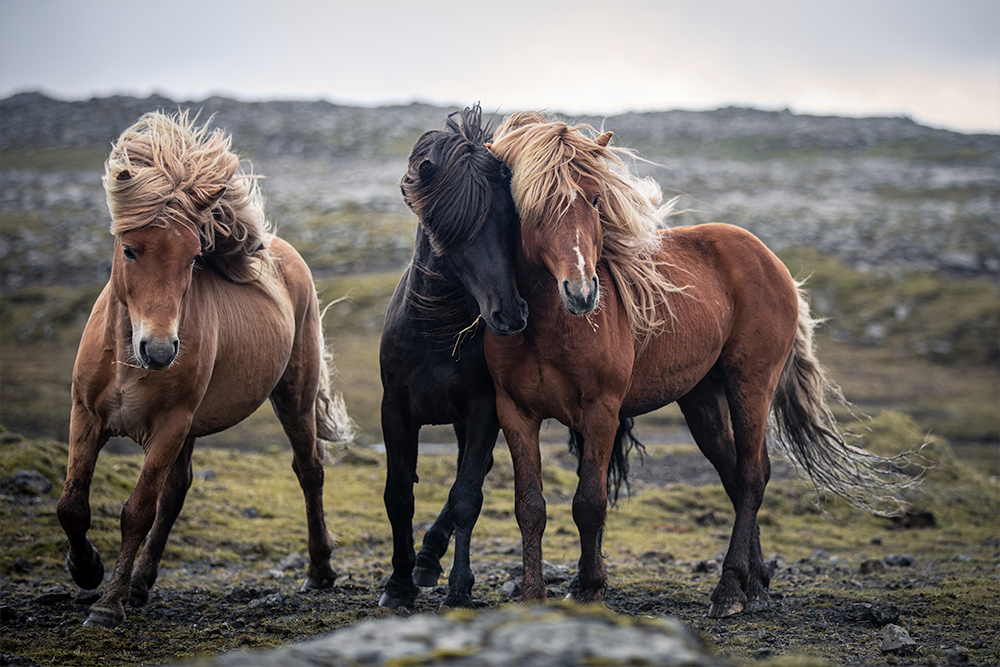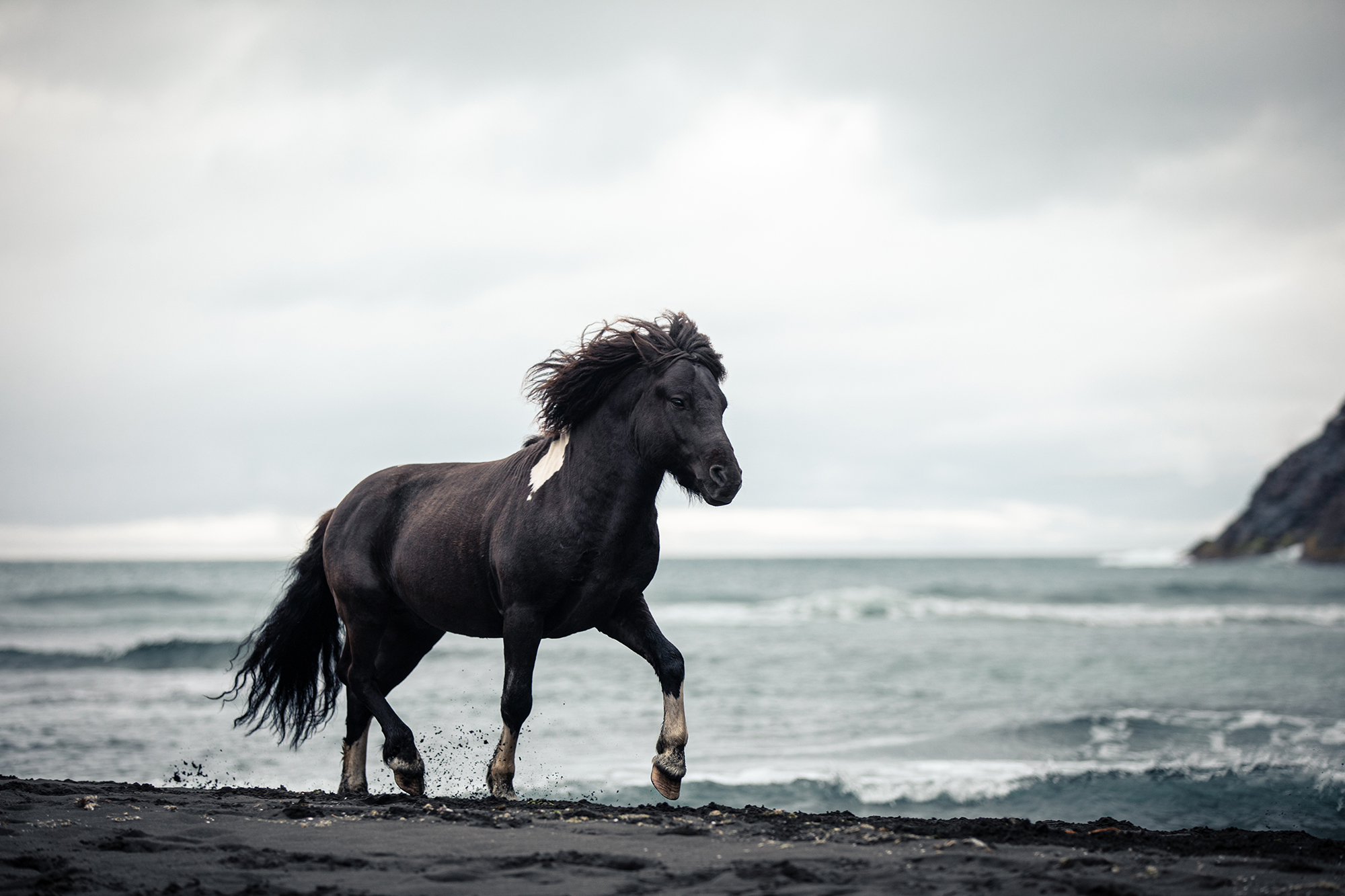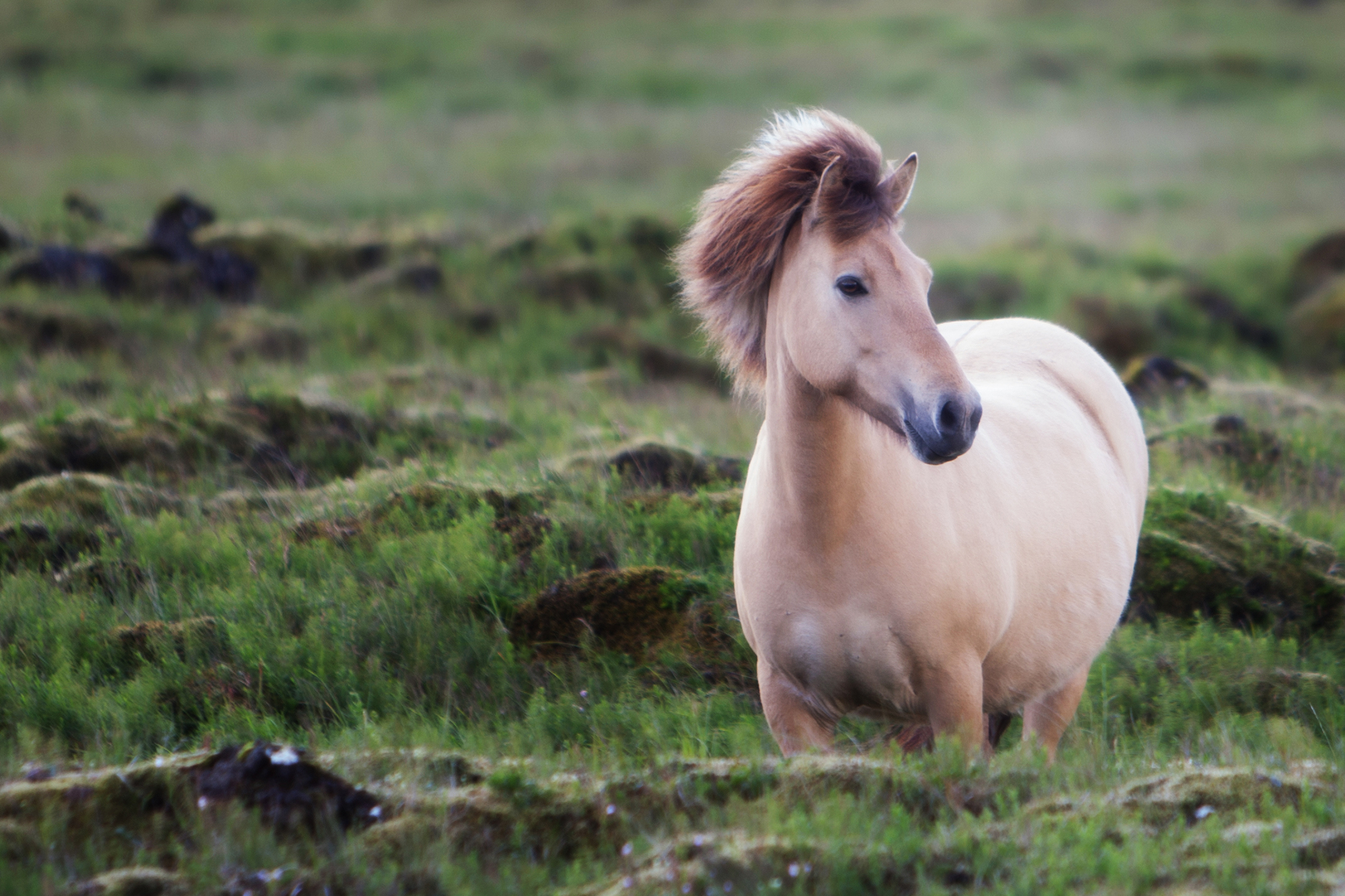

Faroese horse. Photo: Cécile Zahorka / The Pixel Nomad & Vor-die-Linse Fotografie

Icelandic horse. Photo: iStock
3.2 The Faroe Islands
Background
Norse settlers brought horses to the Faroe Islands in the 9th and 10th centuries. Over the centuries, these horses adapted to the rough climate on the islands, and the Faroe Islands became home to a horse breed that was small, strong, hardy, and agile. It is the size of a pony, but is known as the Faroese horse. The horse is most closely related to the Icelandic horse, but also some of the British native breeds. The small horses were mostly used for transport between villages as there were no roads. The horses were semi-wild and roamed the mountains all year and no targeted breeding took place, but their temperament was still mild. The oldest record available of horses on the Faroe Islands is from 1857, which counted 844 horses with 396 mares, and 476 foals and stallions. The horses were then exported massively to Great Britain to be used in the coal mines. The modernization of agriculture on the Faroe Islands made them less needed there, which resulted in a breed that nearly went extinct. By the 1960s, there were less than ten horses of the breed left alive. A rescue operation was initiated, and suitable horses for breeding were used, however many of them were already related. All Faroese horses alive today, are descendants of only four individual horses.
The largest issue for the Faroese equine sector today is that any horse born on the islands cannot be transported internationally as there is no legislative body that can issue horses an EU passport. Subsequently, breeders of the Faroese horse are prevented from selling foals abroad. Further, there are only few local buyers interested in owning this horse on the Faroe Islands. The most popular breed on the Faroe Islands today is the Icelandic horse, which is used for competition and sporting. The lack of opportunity for breeders to sell their foals abroad severely limits conservation work, increasing the risk of extinction due to either infectious diseases or other unforeseen events (Kjetså et al., 2024).
Organization and registration of horse breeding in the Faroe Islands
Until the 1988 legislation for horse breeding activities were strict according to “horse breeding advancement and promotion” (act no. 51, March 14, 1931). The act was abolished by parliament in 1988 without foundation of any new legislation, which is why it can be assumed that breeding standards and overall assessment of stallions and breeding mares in general has been unregulated since 1988. The lack of legislation and possibility of obtaining EU passports for horses born on the Faroese Islands is a probable factor in why there is no breeding activity for other breeds on the islands other than the Faroese horse. Most people who want to buy a horse will buy horses from abroad that are already in possession of an EU passport and thus can be transported in and out of the country freely.
There is no national registration of horses in the Faroe Islands, but breed associations register the breeds in their own breed associations. At present there are two breed associations on the Faroe Islands, one that focuses on the Faroese horse, and one that focuses on the Icelandic horse:
Felagið Føroysk Ross (Faroese Horse Association
Føroyskt Íslandsrossafelag (Faroese Icelandic Horse Association
Population Statistics
The DAD-IS database only has two entries for the Faroese horse, in 2016 and 2017. However, all Faroese horses are registered in the database FøroyaFongur and the breed is well documented from 1960 until today (Figure 2).
Figure 2: The Faroese horse population from 1960-2023.
Source: numbers from FøroyaFongur. Graph by NordGen.
Source: numbers from FøroyaFongur. Graph by NordGen.
When it comes to the other breeds on the Faroe Islands, there is no central register of horses residing on the islands. In 2022, the number of horses of each breed on the islands were estimated from contacts in the Faroese horse sector. With such a small horse sector, it is likely these numbers are not too far off, however, but the numbers could be deviating from the actual number. The number for Faroese horse at the time is extracted from FøroyaFongur. It is also important to consider that the number of Faroese horses depicted here do not represent the current population in 2024, which is 82.
Name of Breed | N total 2022 | Number of foals born 2022 |
Faroese horse | 92 | 2 |
Icelandic horse | 388 | |
Shetland Pony | 8 | |
Norwegian Fjord horse | 5 | |
Other breeds/mixes | 16 | |
Total number of horses | 509 | 2 |
Table 3: The number of horses of each breed on the Faroe Islands, estimated in April 2022. Source: Personal communication with contacts in the Faroese horse sector.
The situation for the Faroese horse is critical. After many years of increased population size for the Faroese horse, the population reached a peak in 2021 with 94 live horses. However, the number of foals born each year has been stagnating since 2019, and the loss of many older horses and unforeseen events have led to a drastic population decline in the last two years (Figure 2). The main reason for the lack of foals born is because that the breeders have not been able to sell their foals, and thus stopped breeding their mares in fear of not being able to sell them. This is reflected in Figure 3, that shows how only a small percentage of the available breeding mares have been utilised since 2019. As long as there is no possibility to sell the foals abroad, this will probably be a continued trend for the Faroese horse and the outlook for the breed is not good.
Figure 3: Breeding mares, and number of foals born from 2010 to 2023.
Source: The Faroese horse Action Plan, Kjetså et al. 2023. The figure illustrates the total number of mares (dark blue), the number of potential breeding mares (blue), the number of foals born (light blue), and the percentage of potential breeding mares used in breeding (yellow line).
Source: The Faroese horse Action Plan, Kjetså et al. 2023. The figure illustrates the total number of mares (dark blue), the number of potential breeding mares (blue), the number of foals born (light blue), and the percentage of potential breeding mares used in breeding (yellow line).
Commercial horse and breeding activities
There are five riding/sporting associations on the islands. These associations focus on creating activities such as competitions and education. The sport associations are under the umbrella organization Ríðisambandið, which is also part of the Faroese Sport Association (Ítróttasamband Føroya). Some description of the associations is provided below:
Ríðisambandið
Føroya Ríðingarfelag (Faroe Islands Riding Association
Vága Ríðingarfelag is a small sporting association for the island of Vágar. The association focuses on two annual competitions in cooperation with Føroya Ríðingarfelag. They are building a stable area with a riding hall that will soon be ready for use. Most horses are included in WorldFengur.
Suðurross - Suðuroyar Hestafelag
Sleipnir is a new and small sporting association for the island of Eysturoy. They are in the process of building everything up, and their current focus is carrying out different activities. Most of the horses are included in WorldFengur.
Dalaross is a small sporting association in Kollafjørður, 20 min from Tórshavn. Their current focus is carrying.
Economy
There are no official numbers on the economic impact of the Horse sector on the Faroe Islands. However, it is likely that the horse sector positively impacts the economy by providing work for citizens through e.g. riding tours for tourists, riding instructors, veterinarians and others servicing the horse owners.
The vegetation on the Faroe Islands mostly consists of grassland vegetation and is heavily grazed by sheep. This causes limitation for horse grazing, and winter hay and feed for the horses is mostly imported from other countries.
Native breeds and conservation programs
The Faroese Agricultural Agency is the governmental branch responsible for the conservation of the Faroese horse breed. However, most of the conservation work is conducted on a volunteer basis through the collaboration between the Faroese Horse Association and the Faroese Agricultural Agency. It is mandatory to register the Faroese horse in the “Føroyafongur” database. The database is managed by the breed association and based on collaboration with the international Icelandic breed database “WorldFengur”.
The critical status of Faroese horse and necessary actions to preserve them are thoroughly described in a newly published Action Plan for the conservation of the Faroese horse (Kjetså et al., 2024). One of the actions described in the Action plan was to export Faroese horse embryos abroad, due to the issue of not being able to export live horses abroad, and the critical need to increase the population of the Faroese horse. The Faroese Horse Association has been granted some funding and have taken action by initiating a project to export embryos to Denmark through Icelandic horse surrogate mares. The first embryo foals will hopefully be born in 2025. However, this is a costly method of getting the horse breed exported abroad and there is a limit to how many foals can be born this way. Other actions would be to work towards being able to obtain EU passports for horses born on the Faroe Islands so that they can be exported, and to make an official breeding program for the breed that conserves genetic diversity.
Gene banking activities
There is currently no gene banking program for the Faroese horse, but 9 stallions have their semen stored at the agricultural agency. Furthermore, efforts to establish a gene bank conservation program for the Faroese horse are ongoing.
Subsidies
The Faroese government provides approximately 40 000 euros yearly for the conservation of the Faroese horse. The money is distributed by the Agricultural Agency for the owners and keepers of breeding mares and stallions, projects involving the preservation of the breed, and to support the work of the Faroese Horse Association.